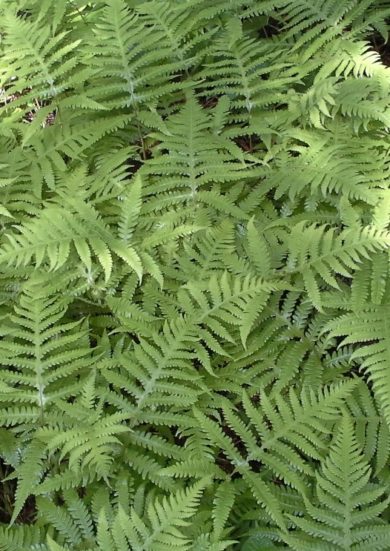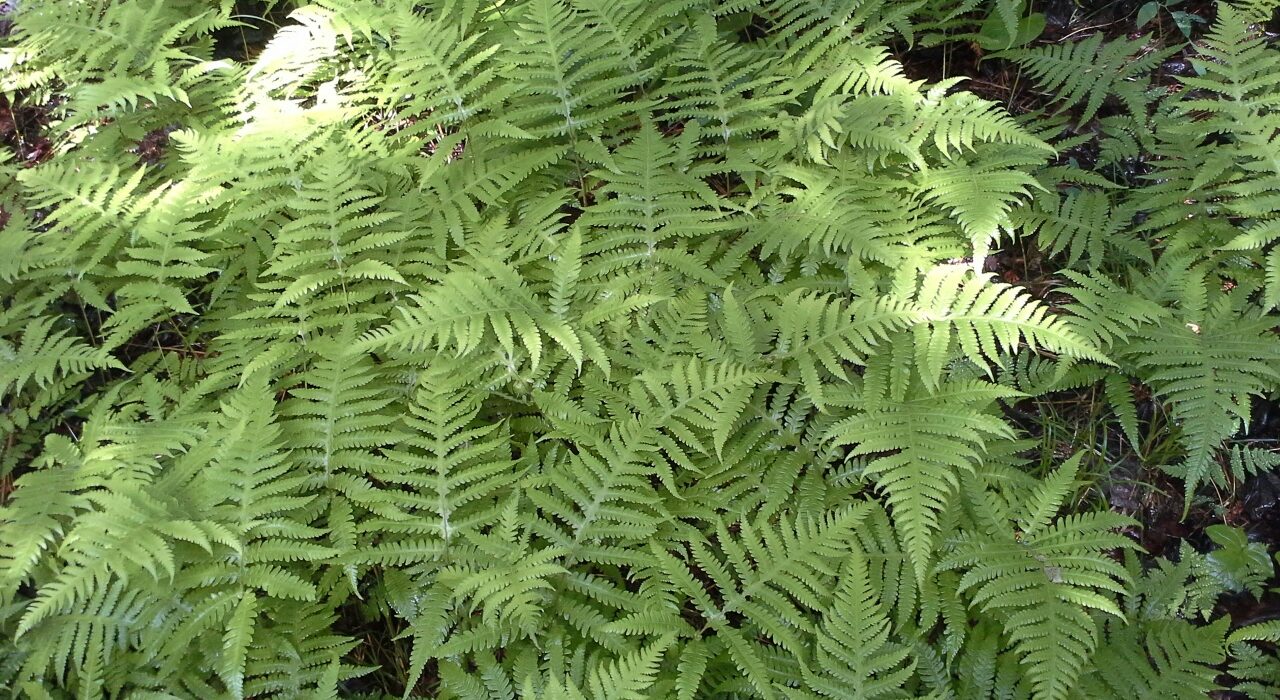In the late 1960’s, two Québec botanists, Lionel Cinq-Mars and Lawrence Sherk trekked through the woods near Montreal. During this time, they collected a fern specimen for cultivation that they thought was Broad Beech Fern (Phegopteris hexagonoptera). Following cultivation and further study, another group of botanists at Ottawa recognized that this particular Broad Beech Fern was very different than those that had been found previously.
The Broad Beech Fern is a sexual diploid. It requires spores from one fern to fertilize another individual fern for reproduction to occur (they can also reproduce asexually by sending out rhizomes—horizontal underground stems—which sprout new fern fronds). The fern specimen that Cinq-Mars and Sherk had collected was not a diploid, rather it was an apomictic (does not reproduce sexually) tetraploid (4 sets of chromosomes, rather than the 2 sets in the diploid cells resulting from sexual reproduction).
This finding, along with its slightly different morphology, caused the Ottawa botanists to propose that this fern was of hybrid origin, descended from Broad Beech Fern and another closely related species of beech fern found in the area, Long Beech Fern (P. connectilis). Long Beech Fern has a roughly circumboreal distribution, including northeastern North America. In this part of its range, Long Beech Fern is a triploid, with three sets of chromosomes in each cell, and is also apomictic (asexual).
This may have been where the story ended, if it were not for Art Gilman, a Vermont native horticulturist turned botanist and author of the New Flora of Vermont. In the early 1980s, Art became interested in ferns and began to study them in earnest. By 1993, he was well-equipped with a mental fern identification book when he stumbled upon an interesting fern in Northfield, Vermont. Like his predecessors Cinq-Mars and Sherk, Art believed that he was looking at a specimen of Broad Beech Fern. However, upon further examination of the fern’s morphology, Art realized that he was looking at something different.

Tall Beech Fern, © Art Gilman
While all of the pinnae of Broad Beech Fern are connected by “wings of green leaf-tissue along the rachis” (the rachis is the central “stem” of the fern frond), including the bottom two pinnae, the fern Art found had basal pinnae that were not completely connected to the next set of pinnae by leaf-tissue along the rachis. Differences in spores, colony appearance, frond length, and basal pinnae pushed Art to investigate his fern specimen further – it appeared to be the same “hybrid” found in Montreal.
Art took his specimen to the University of Vermont, enlisting the help of Professor of Botany David Barrington and his student, Heather Driscoll, to look at his specimen on a molecular basis. They conducted analysis of isozymes (specific enzymes) within the plant’s tissues and compared it to those of Broad and Long Beech Ferns. This analysis indicated that the specimen was closely related to Long Beech Fern, but was not a descendant of Broad Beech Fern, refuting the hypothesis that it arose from a hybridization event between the two species. Further genetic analysis conducted by UVM graduate student Nikisha Patel in the Barrington Lab showed that this plant shares a portion of its genome with Long Beech Fern, and likely did arise from a hybridization event, just not that between Long and Broad Beech Ferns.
After studying specimens of P. connectilis, P. hexagonoptera, and the now-described P. excelsior from different populations across their respective ranges, the combination of morphological, isozyme, genetic, and reproductive distinctions of P. excelsior was found to be complete enough to name P. excelsior a distinct species. Phegopteris excelsior has multiple populations found from Nova Scotia to New York, and from Quebec to Connecticut. It is thought to be endemic to the aforementioned range, as it has only been found in the glaciated Northeast.
Phegopteris excelsior, which Art calls Tall Beech Fern, is most similar morphologically to P. connectilis but can be distinguished by its larger frond size, generally 50 to 60 cm, more triangular blade size, proportionately narrower basal pinnae, and larger spore size. When asked about any habitat preference differences that help to differentiate Tall Beech Fern from the other two beech fern species of this region, Art said, “well, habitat is generally the same but there are small differences.” Long Beech Fern is frequently found in mountainous regions, right up to the tree line at times, while Broad Beech Fern is usually found in lowland areas. It seems that Tall Beech Fern likely overlaps with the preference of the other two species, residing in the middle. Art said that the location in Northfield where he first found Tall Beech Fern was around 1,300 feet in elevation, and he has not found it to commonly occur in lowland areas. It seems to have a preference for moderately rich forests in these mid-elevation ranges.
To learn more about this species, check out this identification guide by Art. The full paper describing the new species can be found here.







